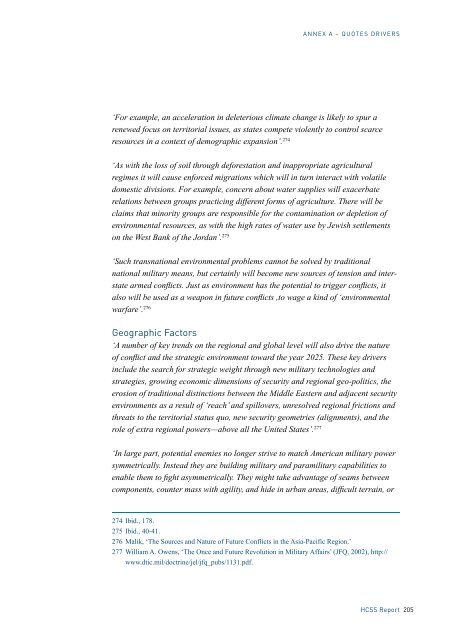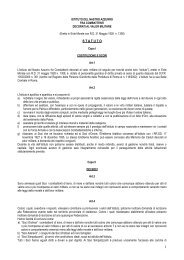Contours of Conflict in the 21st Century
Contours of Conflict in the 21st Century
Contours of Conflict in the 21st Century
- No tags were found...
Create successful ePaper yourself
Turn your PDF publications into a flip-book with our unique Google optimized e-Paper software.
ANNEx A – QUOTES DRIVERS‘For example, an acceleration <strong>in</strong> deleterious climate change is likely to spur arenewed focus on territorial issues, as states compete violently to control scarceresources <strong>in</strong> a context <strong>of</strong> demographic expansion’. 274‘As with <strong>the</strong> loss <strong>of</strong> soil through deforestation and <strong>in</strong>appropriate agriculturalregimes it will cause enforced migrations which will <strong>in</strong> turn <strong>in</strong>teract with volatiledomestic divisions. For example, concern about water supplies will exacerbaterelations between groups practic<strong>in</strong>g different forms <strong>of</strong> agriculture. There will beclaims that m<strong>in</strong>ority groups are responsible for <strong>the</strong> contam<strong>in</strong>ation or depletion <strong>of</strong>environmental resources, as with <strong>the</strong> high rates <strong>of</strong> water use by Jewish settlementson <strong>the</strong> West Bank <strong>of</strong> <strong>the</strong> Jordan’. 275‘Such transnational environmental problems cannot be solved by traditionalnational military means, but certa<strong>in</strong>ly will become new sources <strong>of</strong> tension and <strong>in</strong>terstatearmed conflicts. Just as environment has <strong>the</strong> potential to trigger conflicts, italso will be used as a weapon <strong>in</strong> future conflicts ,to wage a k<strong>in</strong>d <strong>of</strong> ‘environmentalwarfare’. 276Geographic Factors‘A number <strong>of</strong> key trends on <strong>the</strong> regional and global level will also drive <strong>the</strong> nature<strong>of</strong> conflict and <strong>the</strong> strategic environment toward <strong>the</strong> year 2025. These key drivers<strong>in</strong>clude <strong>the</strong> search for strategic weight through new military technologies andstrategies, grow<strong>in</strong>g economic dimensions <strong>of</strong> security and regional geo-politics, <strong>the</strong>erosion <strong>of</strong> traditional dist<strong>in</strong>ctions between <strong>the</strong> Middle Eastern and adjacent securityenvironments as a result <strong>of</strong> ‘reach’ and spillovers, unresolved regional frictions andthreats to <strong>the</strong> territorial status quo, new security geometries (alignments), and <strong>the</strong>role <strong>of</strong> extra regional powers—above all <strong>the</strong> United States’. 277‘In large part, potential enemies no longer strive to match American military powersymmetrically. Instead <strong>the</strong>y are build<strong>in</strong>g military and paramilitary capabilities toenable <strong>the</strong>m to fight asymmetrically. They might take advantage <strong>of</strong> seams betweencomponents, counter mass with agility, and hide <strong>in</strong> urban areas, difficult terra<strong>in</strong>, or274 Ibid., 178.275 Ibid., 40-41.276 Malik, ‘The Sources and Nature <strong>of</strong> Future <strong>Conflict</strong>s <strong>in</strong> <strong>the</strong> Asia-Pacific Region.’277 William A. Owens, ‘The Once and Future Revolution <strong>in</strong> Military Affairs’ (JFQ, 2002), http://www.dtic.mil/doctr<strong>in</strong>e/jel/jfq_pubs/1131.pdf.HCSS Report 205










